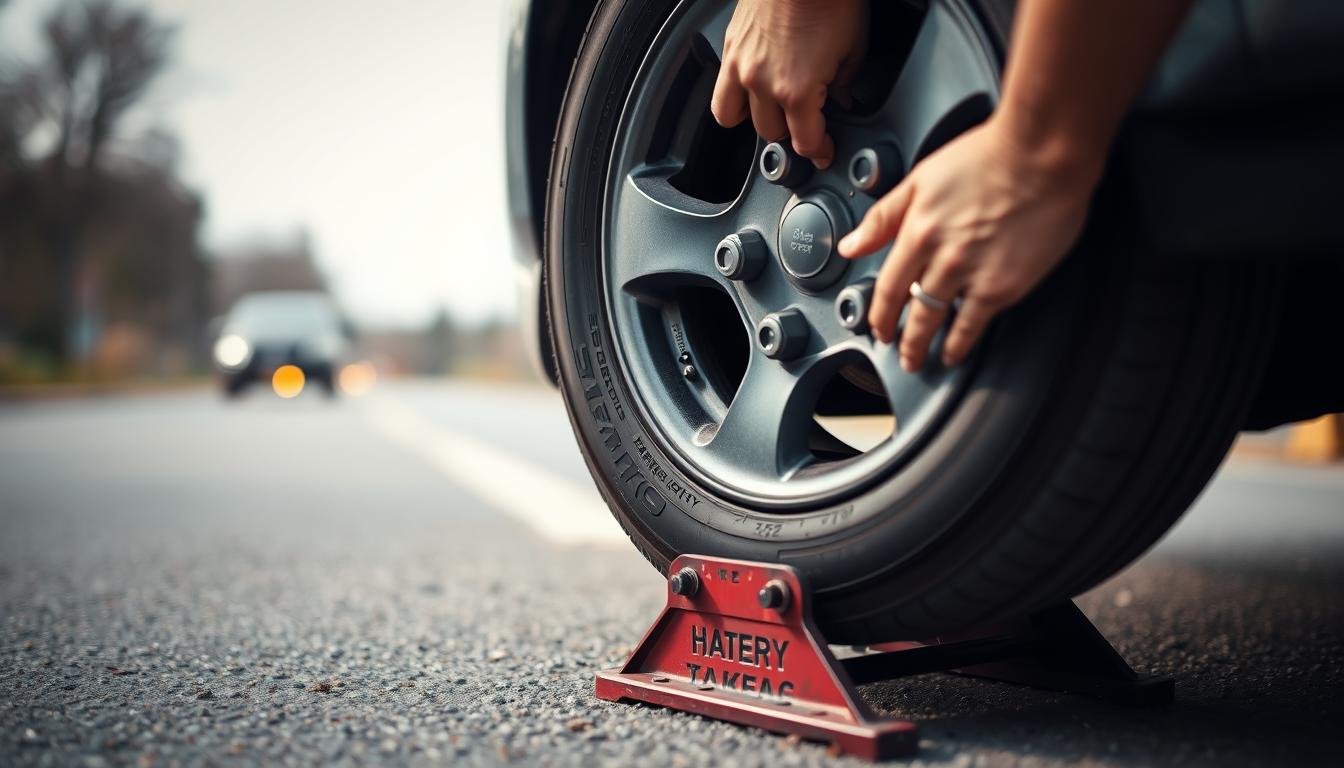Flat Tire? Here’s How to Change It Safely and Confidently Step by Step
You’re driving along, enjoying your tunes, when you hear that thud-thud-thud. A flat tire. Panic is natural, but it’s not necessary. Learning how to change a flat tire safely can make you feel more confident.
Knowing how to fix a flat tire car is essential for every driver. It’s useful whether you’re on a long trip or get a flat tire unexpectedly. It saves time, money, and stress.
By following safe tire change tips, changing a tire becomes easy. This guide will show you how to do it step by step. You’ll be ready for any roadside problem.
Key Takeaways
- Recognize the signs of a flat tire and know when to pull over.
- Use hazard lights and apply the parking brake for safety.
- Understand the proper use of a jack, lug wrench, and spare tire.
- Follow a step-by-step guide to changing a flat tire.
- Stay calm and confident when dealing with a flat tire.
Understanding Flat Tires and Being Prepared
A flat tire can happen to anyone, anywhere. Knowing what to do can help you manage it well. It’s key to know what causes flat tires and how to spot them.
Common Causes of Flat Tires
Flat tires often come from punctures by sharp objects on the road, like nails or glass. Other reasons include tire wear and tear, not checking tire pressure, and hitting potholes. Regular checks can find wear, damage, or objects in the tire.
Keeping your car tire pressure right is also important. Underinflated tires can get damaged or overheat, leading to a blowout. Damage from hitting curbs or accidents can also cause flats.
Signs You Have a Flat Tire
Knowing the signs of a flat tire helps you act fast. Look for a drop in tire pressure, a tire that’s losing shape, or your car pulling to one side. You might also hear a flapping sound or feel vibrations.
If you think you have a flat tire while driving, pull over to a safe spot. This lets you check the tire more closely.
Essential Tools for Changing a Tire
Having the right tire changing tools is very important. You’ll need a lug wrench, a spare tire, and a car jack. Knowing where your spare tire is can also be helpful.
Understanding flat tire causes, knowing the signs, and having the right tools makes you ready for a flat tire. You’ll feel more confident handling it.
Safety First: Preparing to Change Your Flat Tire
Before you start changing your flat tire, make sure you’re ready. Your safety and the safety of others are top priorities. Follow these steps to avoid accidents and make the process smoother.
Finding a Safe Location to Pull Over
First, move your car to a safe spot. Look for a flat, stable, and well-lit area, away from traffic. This could be a wide shoulder, a parking lot, or any other spot that is far from oncoming vehicles. Turn off the engine and engage the parking brake to ensure your vehicle does not move while you’re changing the tire.
Proper Use of Hazard Lights and Safety Equipment
Once you’ve found a safe location, turn on your hazard lights to alert other drivers. This is key for visibility, even in low-light conditions or heavy traffic. Also, use warning triangles or flares around your vehicle to alert other drivers further.
Securing Your Vehicle Before Starting
Securing your vehicle is a must. Apply the parking brake to prevent the vehicle from rolling. If you’re on an incline, consider using wheel wedges or chocks for extra safety. This keeps your vehicle stationary while you work on it.
Staying Visible to Other Drivers
When changing a tire, being visible is key. Wear bright or reflective clothing to be seen by passing drivers. If it’s dark or visibility is poor, use a flashlight or other light source. Stay alert and be aware of your surroundings at all times.
| Safety Measure | Description | Importance Level |
|---|---|---|
| Safe Location | Move to a flat, stable area away from traffic | High |
| Hazard Lights | Turn on hazard lights to alert other drivers | High |
| Parking Brake | Engage the parking brake to prevent vehicle movement | Critical |
| Wheel Wedges | Use wheel wedges on inclines for extra safety | High |
| Reflective Clothing | Wear bright or reflective clothing for visibility | High |
Getting Your Tools and Spare Ready
Getting your spare tire and tools ready is key to safely changing a flat tire. Make sure you have everything you need within reach before starting.
Locating Your Spare Tire and Tools
First, find your spare tire and the tools that come with it, like the lug wrench and jack. They’re usually in your car’s trunk. If you’re not sure where they are, check your car’s manual.
Understanding Your Jack and Lug Wrench
It’s important to know how to use the jack and lug wrench right. The jack lifts your car, and the lug wrench loosens the wheel nuts. Read the instructions or practice in a safe spot to get familiar.
Inspecting Your Spare Tire Before Use
Check your spare tire regularly before using it. Look for signs of wear and make sure it’s inflated. A well-kept spare tire can prevent a lot of stress in an emergency.
Different Types of Spare Tires
There are various spare tires, like full-size spares, temporary spares, and run-flat tires. Knowing what type your car has is important. For example, a temporary spare should be replaced with a full-size tire as soon as you can.
How to Change a Flat Tire Safely: Step-by-Step Process
Changing a flat tire is easier than you think. With a bit of practice, you’ll get the hang of it. It’s important to be careful and follow the right steps to stay safe.
Loosening the Lug Nuts
Start by loosening the lug nuts with a lug wrench. Turn them counterclockwise until they’re loose. Don’t remove them yet. This makes them easier to take off when the car is up.
Properly Positioning the Jack
Positioning the jack right is key. Check your car’s manual for the best jacking points. These are metal spots on the frame made for lifting the car.
Finding the Correct Jack Points
Look for the jacking points on your car’s frame. They’re marked or in the manual. Using the right spots helps avoid damage.
Safe Jacking Techniques
After finding the right spots, put the jack under the car. Raise it until the flat tire is off the ground. Make sure the jack is stable before removing the lug nuts.
| Jacking Technique | Description |
|---|---|
| Correct Jack Placement | Place the jack on a firm, level surface and at the correct jacking point. |
| Stable Jacking | Raise the vehicle until the flat tire is off the ground, then stabilize the jack. |
Removing the Flat Tire
With the car raised, you can remove the lug nuts and take off the flat tire. Put the lug nuts in a safe place so they don’t get lost.
“The key to changing a tire is to be methodical and not rush the process. Safety should always be your top priority.”
Installing the Spare Tire
Put the spare tire on the wheel hub and hand tighten the lug nuts. Make sure the tire is centered and seated before tightening more.
Properly Tightening Lug Nuts in the Correct Pattern
Lower the car and then tighten the lug nuts in a star pattern. This prevents wheel damage. Check your manual for the right torque.
By following these steps, you can change a flat tire safely and confidently. Remember, practice makes perfect, so try it in a safe place.
Finishing the Job Correctly
Finishing a tire change is important for your safety. First, make sure your car is back on the ground. Then, tighten the lug nuts well and put away all tools.
Lowering the Vehicle Safely
Lower your car carefully using the jack. Make sure it’s stable before you take the jack away. Never get under the vehicle while it’s supported by a jack. After it’s on the ground, rock it gently to check if it’s stable.
Final Tightening of Lug Nuts
With your car on the ground, tighten the lug nuts as much as you can in a star pattern. This makes sure the wheel is tight. Look in your car’s manual for how tight the lug nuts should be.
- Tighten lug nuts in a star pattern to ensure even tightening.
- Use a lug wrench to tighten the nuts as much as you can.
- Check the lug nuts again after driving a short distance.
Storing the Flat Tire and Tools Properly
After the tire change, put the flat tire, jack, and lug wrench where they belong. Make sure they’re secure and won’t move while driving. It’s also good to check your spare tire’s condition and pressure.
- Place the flat tire in the trunk or designated storage area.
- Store the jack and lug wrench in their original positions.
- Double-check that all tools are accounted for.
By following these steps, you ensure a safe and proper finish. Always check your car’s manual for specific instructions.
Overcoming Anxiety: Changing a Tire with Confidence
With a little preparation and knowledge, you can change a tire confidently. It’s a skill every driver should have. Being ready is key to handling stress during emergencies.
Managing Stress During a Roadside Emergency
When you get a flat tire, stress can hit you hard. But, staying calm and following a systematic approach can help a lot. Take deep breaths, assess the situation, and remember you can change the tire.
Preparation is your best ally in managing stress. Get to know your vehicle’s tire changing tools and practice in a safe place. This will lower your stress and make the process smoother.
Building Confidence Through Preparation
Confidence comes from knowing what to do and being ready. Regularly inspect your tire changing equipment and make sure your spare tire is good. Knowing how to use your jack and lug wrench is key.
To boost your confidence, follow these steps:
- Learn your vehicle’s manual and the right way to change a tire.
- Practice changing a tire in a safe place, like an empty parking lot.
- Check your tire pressure often and keep your spare tire ready.
When to Practice Changing a Tire
The best time to practice changing a tire is before you actually need to. Find a safe spot, like an empty parking lot, and go through the steps. This hands-on experience will boost your confidence.
Also, check out this table for the benefits of practicing tire changes:
| Benefit | Description |
|---|---|
| Increased Confidence | Practicing tire changes makes you more confident in your ability to handle roadside emergencies. |
| Reduced Stress | Knowing what to do in case of a flat tire reduces stress and anxiety during actual emergencies. |
| Improved Safety | Being prepared and knowledgeable about tire changes enhances your safety on the road. |
By following these tips and practicing, you’ll be ready to manage stress and change a tire confidently. Remember, the key to overcoming anxiety is preparation and practice.
Special Situations and Challenges
Changing a tire can be tricky, like in bad weather or at night. Being ready for these situations helps keep you safe and makes the job easier.
Changing a Tire in Bad Weather
Changing a tire in rain or snow is extra careful. The ground is slippery, and you can’t see well. Wear gloves to hold tools better.
Tips for Changing a Tire in Bad Weather:
- Find a flat, dry spot to change the tire.
- Turn on hazard lights to be seen by others.
- Watch your steps to avoid slipping.
Changing a Tire at Night
Changing a tire at night is hard because it’s dark. You need a good light, like a flashlight or hazard lights, to see what you’re doing.
Key Considerations for Nighttime Tire Changes:
- Position your car so headlights shine on the flat tire.
- Use a flashlight if the headlights aren’t enough.
- Be careful because you can’t see as well.
Dealing with Stuck or Rusted Lug Nuts
Stuck or rusted lug nuts make changing a tire harder. Use penetrating oil and the right tools to loosen them. If they’re really stuck, you might need a pro.
| Problem | Solution |
|---|---|
| Stuck Lug Nuts | Apply penetrating oil and use a breaker bar for extra leverage. |
| Rusted Lug Nuts | Use a rust-dissolving product and consider replacing the lug nuts. |
When to Call for Professional Help
If you’re not sure you can change the tire, call for help. Roadside assistance can get you the help you need fast and safely.
Signs You Should Call for Help:
- You’re not sure you can change the tire.
- The tire is on a busy road, and it’s not safe.
- The lug nuts are stuck and you can’t get them loose.
Changing Tires on Different Vehicle Types
Changing tires on different vehicles can be different. Trucks or SUVs might need stronger tools, while some cars have special instructions.
Considerations for Different Vehicles:
- Check your car’s manual for specific instructions.
- Make sure you have the right tools for your vehicle.
- Follow any special procedures recommended by the manufacturer.
Common Mistakes to Avoid When Changing a Flat Tire
It’s important to avoid common errors when changing a flat tire. This can prevent accidents and injuries. Knowing the pitfalls can help keep you safe and ensure the tire change goes well.
Improper Jack Placement
One big mistake is putting the jack in the wrong spot. The jack should be on the vehicle’s frame, near the flat tire. Improper jack placement can cause the vehicle to fall off, leading to serious harm or damage. Always check your vehicle’s manual for the right jacking points.
Incorrect Lug Nut Tightening
Incorrect lug nut tightening is another common error. Over-tightening can harm the wheel or brake parts. Under-tightening can cause the wheel to come loose while driving. It’s key to tighten lug nuts in a star pattern and to the correct torque.
| Lug Nut Tightening Pattern | Description | Torque Specification |
|---|---|---|
| Star Pattern | Tighten lug nuts in a star (or crisscross) pattern to ensure even tightening. | Refer to vehicle manual |
| Sequential Pattern | Avoid tightening lug nuts sequentially as it can lead to uneven pressure. | Not Recommended |
Forgetting Safety Precautions
Forgetting safety precautions is a big mistake. Always turn off the engine, engage the parking brake, and put the vehicle in park (automatic) or first gear (manual). Use hazard lights and warning triangles to alert other drivers. Wear gloves and safety glasses to protect yourself from hazards.
Neglecting Post-Change Checks
After changing the tire, it’s vital to do post-change checks. Check the tire pressure of the spare tire and drive carefully to the nearest service station to have the flat tire fixed or replaced. Also, check the lug nuts after driving a few miles to make sure they’re tight.
By knowing these common mistakes and avoiding them, you can ensure a safe and successful tire change. Always put safety first when dealing with a flat tire.
After the Change: What to Do Next
Changing a flat tire is just the start. Now, you need to drive safely on your spare tire. Also, get your flat tire repaired or replaced as soon as you can.
Driving Safely on a Spare Tire
Driving on a spare tire needs extra care. Always check your car’s manual for spare tire speed limit and usage tips. Don’t drive too fast or for a long time on a spare tire. Keep your speed down and avoid sudden stops or sharp turns.
- Check the recommended spare tire speed limit in your vehicle’s manual.
- Avoid driving long distances on the spare tire.
- Be cautious and reduce your speed.
Getting Your Flat Tire Repaired or Replaced
After changing your tire, get your flat tire repaired or replaced by a mechanic quickly. Look at the flat tire for damage to see if it can be fixed or needs to be replaced. If you’re not sure, ask a tire expert.
- Inspect the flat tire for damage.
- Consult a tire professional for advice.
- Have the tire repaired or replaced based on the assessment.
When to Replace Your Spare Tire
Your spare tire is only for emergencies. Check it often and replace spare tire when needed. If your spare tire has been used a lot or looks worn out, it’s time to get a new one. Look at your car’s manual for tips on checking and caring for your spare tire.
By following these steps, you can stay safe on the road after fixing a flat tire. Remember, a spare tire is only temporary. Fixing or replacing your flat tire should be your main goal.
Preventative Measures to Avoid Future Flat Tires
By taking a few simple precautions, you can greatly reduce the chance of getting a flat tire. Regular maintenance and being ready are key to avoiding the hassle and danger of a flat tire.
Regular Tire Maintenance Tips
Keeping your tires in good shape is key to avoiding flat tires. This means checking tire pressure often, as low pressure tires are more likely to get damaged. Also, rotating your tires as your car’s manual suggests helps them wear evenly.
- Check tire pressure at least once a month and before long trips.
- Rotate tires every 6,000 to 8,000 miles or as recommended by your vehicle’s manufacturer.
- Inspect tires regularly for signs of wear, such as uneven tread wear or damage.
Proper tire maintenance not only prevents flat tires but also improves your vehicle’s fuel efficiency and handling.
Recognizing Tire Wear Patterns
Knowing tire wear patterns helps you spot issues before they become a flat tire. Common signs include:
- Uneven wear due to improper tire inflation or misaligned wheels.
- Excessive wear on the center or edges of the tire, indicating over or underinflation.
- Wear on one side, which could be due to improper wheel alignment or uneven tire rotation.
Regular inspections can help you catch these issues early, allowing you to take corrective action.
Building a Complete Roadside Emergency Kit
Even with regular maintenance, unexpected issues can arise. Being prepared with a roadside emergency kit can make a big difference. Your kit should include:
- A spare tire and the tools needed to change it.
- A first-aid kit.
- Flashlights and extra batteries.
- Reflective triangles or flares.
- A basic toolkit, including a lug wrench and a car jack.
Having these items on hand can help you handle a flat tire or other roadside emergencies more effectively.
Conclusion
You now know how to change a tire like a pro. This guide has shown you how to handle a flat tire safely. You can get back on the road with confidence.
Knowing what to do with a flat tire is key. This guide has given you the best practices for changing tires. Being ready is essential for handling emergencies.
Remember to keep your tires in good shape and have a roadside emergency kit. These steps can help avoid getting stuck with a flat tire.
Stay informed and prepared to drive with confidence. Knowing how to handle a flat tire keeps you safe on the road.
FAQ
What are the most common causes of a flat tire?
Flat tires often come from sharp objects on the road, tire wear, or not enough air. Also, road hazards can cause them. Keeping your tires in good shape can prevent many of these problems.
How do I know if I have a flat tire?
Look for signs like a drop in tire pressure, the car pulling to one side, or a vibrating steering wheel. You can also check if the tire looks damaged or not full of air.
What tools do I need to change a flat tire?
You’ll need a lug wrench, a car jack, a spare tire, and wheel wedges. Don’t forget a flashlight, gloves, and a first aid kit.
How do I safely change a flat tire?
First, find a safe spot away from traffic and turn on your hazard lights. Lock your car with the parking brake and wheel wedges. Then, loosen lug nuts, jack up the car, remove the flat tire, and put on the spare.
What type of spare tire should I use?
Your vehicle’s manual will tell you what spare tire to use. You might have a full-size spare, a temporary spare, or a tire repair kit.
How tight should I tighten the lug nuts?
Tighten lug nuts in a star pattern until they’re snug. Then, tighten them more when the car is back on the ground. Use a torque wrench to follow the manufacturer’s tightness guide.
Can I drive on a spare tire for an extended period?
Spare tires are for temporary use only. Drive carefully and at moderate speeds to a service station to get your tire fixed or replaced. Always check your owner’s manual for guidance on using a spare.
How can I prevent getting a flat tire in the future?
Regular tire checks, rotations, and inspections for wear can prevent flat tires. Also, avoid road hazards and drive carefully.
What should I do if I get a flat tire at night or in bad weather?
Move to a safe spot as soon as you can, turn on your hazard lights, and be careful when changing the tire. If it’s too dangerous, consider getting help.
When should I call for professional help with a flat tire?
Call for help if you’re not sure how to change the tire, if you’re in a dangerous spot, or if you’re unsure what to do. Many roadside services are available 24/7.
How often should I check my tire pressure?
Check your tire pressure monthly and before long trips. The right pressure improves fuel efficiency, handling, and safety.
What are some common mistakes to avoid when changing a flat tire?
Avoid wrong jack placement, incorrect lug nut tightening, and ignoring safety. Always follow your vehicle’s manual for the right steps.
How do I know when to replace my spare tire?
Regularly check your spare tire for wear or damage. If it’s a temporary spare, replace it after the time or mileage in your owner’s manual.
















